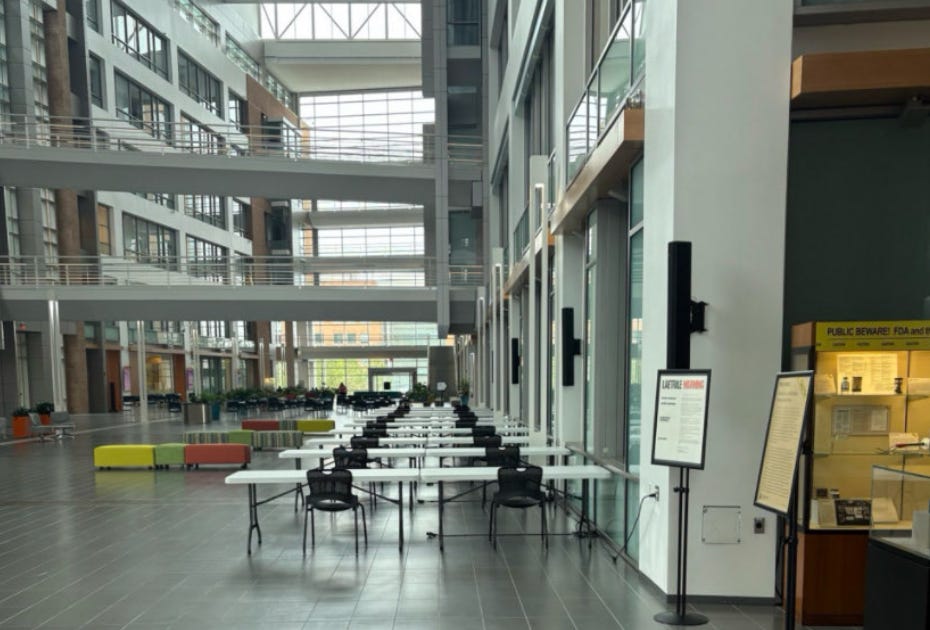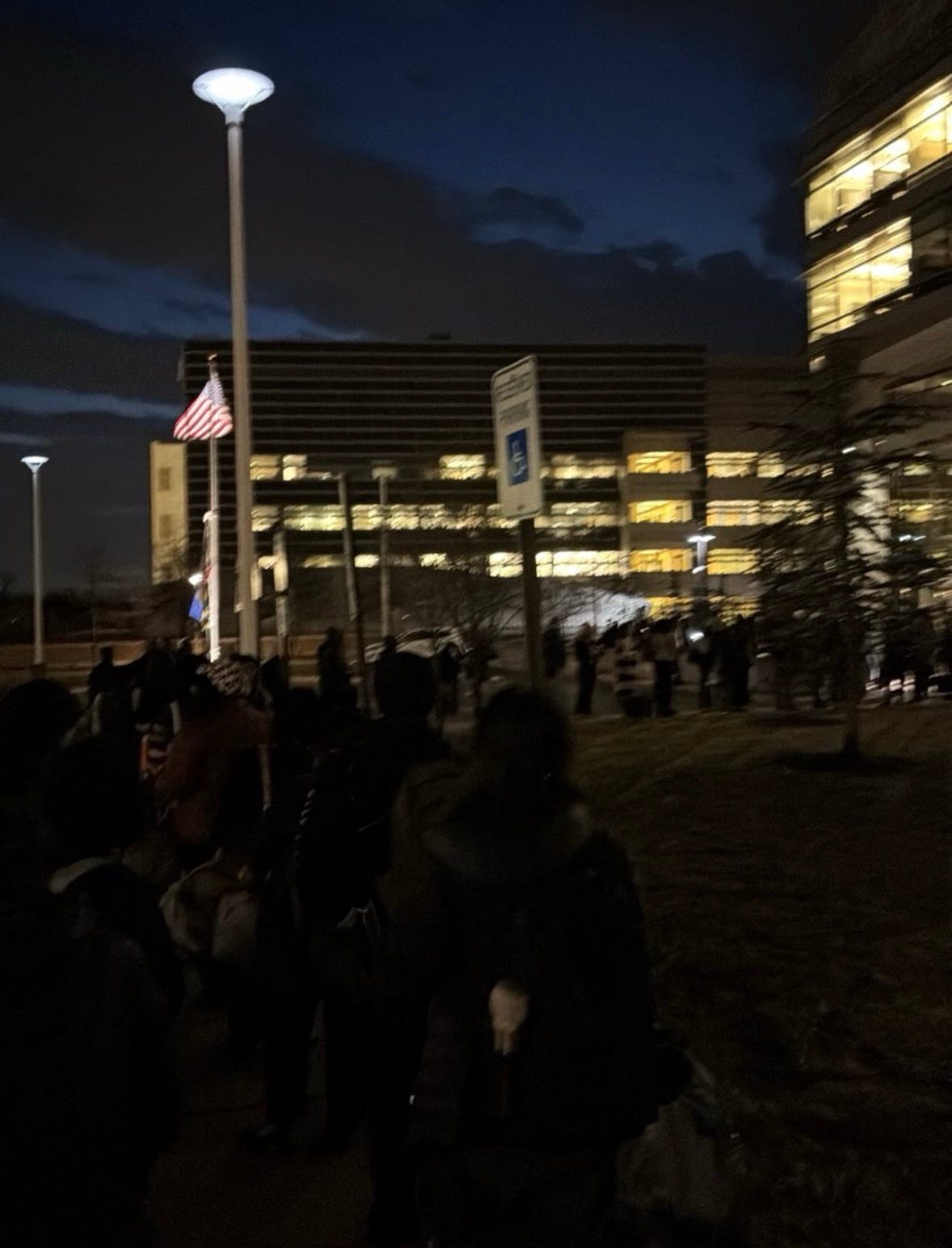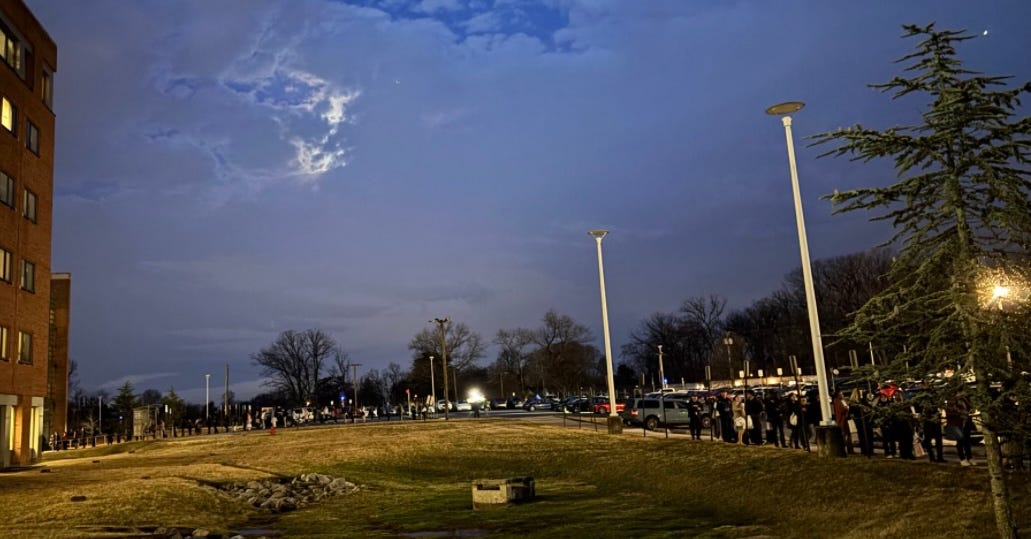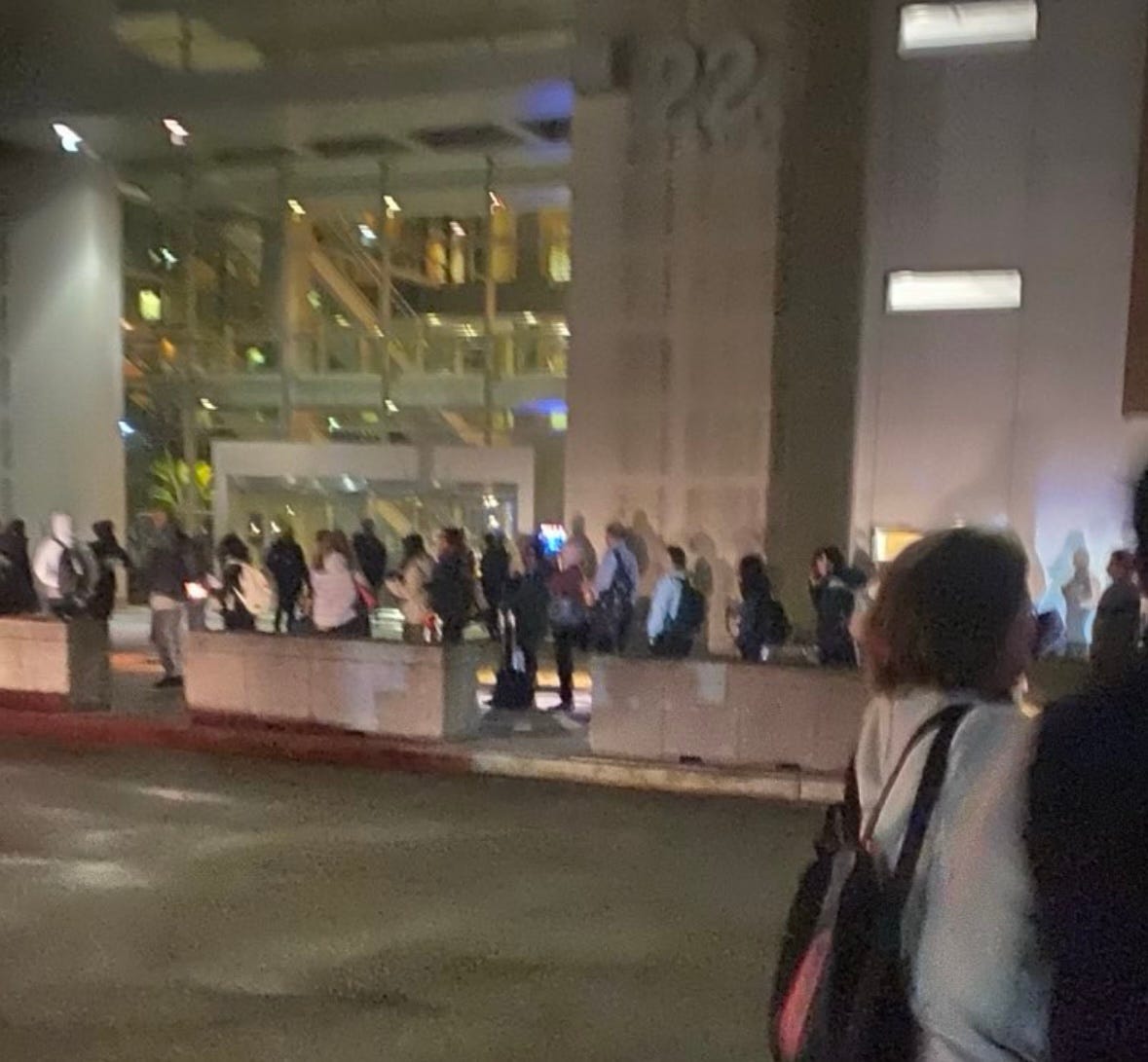Trump’s telework ban kicks in today at the FDA: Staff returns to too few parking spots, too few desks—oh, and some lingering Legionella concerns"
Security lines were already backed up before 6 a.m this morning at the FDA's main campus in Maryland. “It’s an exercise in futility. It’s a performance so we can say we tried."
Hi everyone, I just want to give huge thanks to the many FDA employees who came forward with the details in today’s Inside Medicine. (I’m adding more photos as they come in to the bottom of this article). Their voices and expertise made today’s newsletter possible. I’ll also add that, as I have found in many agencies, these professionals are dedicated to their work, and deserve our support. Let’s get to the chaos that is now unfolding in Maryland.
But first…
If you would like to support work like this, please share and back Inside Medicine. Your likes, shares, and upgrades make this all possible. Thank you!

On his first day in office, President Trump instructed federal agencies to “terminate remote work arrangements and require employees to return to work in-person” as soon as possible. Today, less than two months later, over 10,000 FDA employees are expected to report to White Oak, the agency’s headquarters in Silver Spring, MD.
“It’s an exercise in futility. It’s a performance so we can say we tried,” a current FDA employee told Inside Medicine over the weekend. Similar sentiments were shared by half a dozen other current and former FDA employees who spoke to Inside Medicine on the condition of anonymity so that they could describe the chaotic situation frankly.
Last Thursday, with the Monday return-to-office deadline looming and telework ending, FDA workers attended a hybrid Town Hall meeting to learn about the developing logistics. All of the FDA leaders who presented at the meeting attended in person, with one notable exception: Acting FDA Commissioner—and Trump appointee—Dr. Sara Brenner. Brenner reportedly attended the meeting via Zoom, sporting an FDA vest and “legit looking like she just came from the gym,” another FDA employee said. “The irony was lost on nobody,” added another. “So hypocritical.”
Still, any information was welcome. “If you had asked me a week ago about the rest of the leadership, I would have said they have been basically silent and I have only received information about job changes via Reddit,” another FDA staffer said. “However, this past week, they were far more frank and open about what is going on. The implication was…that the vast majority, if not all, of the decisions were being made at the ‘agency level’ (i.e., HHS) and not the FDA.”
Not enough offices or parking spaces.
The first problem is that the FDA’s main campus is simply not equipped for this kind of workforce. “There are over 10,000 of us, but there are only 6,000 parking spots. There aren’t enough offices. There aren’t enough chairs,” an FDA employee told me.
Former FDA Commissioner Dr. Robert Califf corroborated that, adding that the policy did not serve a useful purpose. “Like a lot of things with these politicians, it’s all about the slogans—no analysis or logic,” he told me yesterday.
Scrambling to make it work, the agency hurriedly tried to secure access to parking at an old abandoned Sears lot, vacant for years. No luck. They also tried to get Montgomery County, where White Oak is situated, to reroute public transit. So far, nothing has materialized.
One additional parking lot at a metro stop has been added but is far from campus, one of the employees said. That means employees will drive to the main campus, wait in traffic to get past the main gate, fail to find parking after driving around looking for a spot, then drive another 20 minutes (depending on traffic) in hopes of finding a spot at the metro station lot. From there, they’ll have to wait for a shuttle and be driven back to campus. “Talk about government efficiency!”
So, FDA employees are expecting chaos today. “People are talking about driving in at 5 or 6 a.m., just to get in,” one said. “Leadership is saying ‘we know that this is a physically impossible task,’ but you have to come in and do it. They feel that we have to perform the infeasibility of it. We need to show that line of cars stuck in a building.”
The problem is that once the parking lots are full, employees who drove in may just have to turn around and go home. “We are being told if we put a good faith effort to get into the building but can’t, we will have to tell our supervisors that we need to be on leave from the day.”
The parking fiasco is expected to be worse than before the pandemic because, prior to Covid, there were parking attendants who would double and triple park cars in garages and surface lots. Unfortunately, the attendants are not coming back because there isn’t a contract in place currently.
Many assume that today and parts of the week will be a complete loss. But this will not be free for rank-and-file employees. “We are not allowed to telework anymore. So we’ll have to use up our own [paid time off] leave.”
No room at the inn, and far worse than before the pandemic.
For employees who do manage to make it into the building today, they may find poor work conditions. Some employees may not even have proper offices, and may be assigned to folding tables and chairs set up in the lobbies. Indeed, rumors that large spaces had been converted into makeshift offices seemed to be confirmed by a photo (see above) that circulated widely in FDA group chats in recent days, showing long plastic folding tables and chairs—and setup that (I couldn’t resist asking) ChatGPT described as one “suggesting an impromptu office arrangement rather than a permanent or well-designed workspace.”
There are also rumors of equipment shortages, untenable noise levels in shared spaces, and even inadequate internet bandwidth.
Prior to the Covid-19 pandemic, the FDA had been ahead of the curve on telework, meaning it could expand its workforce without having to buy more land or adding expensive office space. For example, the White Oak campus was built prior to the creation of the Center for Tobacco Products. Part of the FDA’s strategy in recruiting people to join the Center in the 2010s was to make hybrid telework a standard part of operations. At the time, it was considered an innovative solution because it expanded the talent pool at the FDA without the added expense of additional overhead.
“It saved the government money because the FDA could maintain the same footprint rather than building new facilities,” one employee said, describing the solution as “extremely efficient and supportive of working families. I think most considered the setup the best of both worlds.”
So, unlike many federal agencies for whom “return to office” is a throwback to the pre-pandemic era, implementing the Trump administration fiat to have everyone work on site represents uncharted territory that is unlikely to work well.
Already, some FDA employees have received indications that the agency is aware of the impossibility of the situation. “I had to sign an ad hoc telework agreement this morning,” one of the employees said on Sunday. “I was told by my manager that for tomorrow only, if we can’t find a spot, we can telework.” Other FDA employees I spoke with had not yet received similar instructions or agreements and were expecting to either get a parking space or head home after trying.
Another sign that the agency is expecting problems: employees have also been told that they can log in from home after their core daily ‘tour of duty’ work hours are completed if they need to finish things, which was not initially guaranteed. (Aside: the Trump-Musk perspective on lazy federal employees doing the bare minimum really doesn’t bear out, does it.)
Another employee who lives close to campus said he can take a bus. “I’m much more concerned about lines to get through security. I will definitely be less productive and more distracted with the burden of the new logistical challenges of managing home life,” he added.
Live update: One source sent Inside Medicine this photo of a security line in a building at White Oak already backed up well before 6 a.m. “They are utterly unprepared for managing security. I think there are only seven entrances across campus, many with only one scanner,” the source said. “It’s ten-times worse than your worst airport nightmare.”

The FDA was a leader in leveraging telework. Now it’s going back with little-to-no upside. .
For most federal agencies, telework was an innovation that came with the Covid-19 pandemic. But the FDA had long been leveraging telework to recruit top talent to the agency, starting years before the pandemic. Prior to the pandemic, new FDA hires generally had to work on-site five days a week to prove themselves. But after six to nine months, there were options to work from home half the time or more, which allowed office space to be shared. The policy served both the employees and the agency. “My impression was that this was both for space and flexibility purposes,” one employee added. Once available, nearly everyone took this option, another said. Meanwhile, FDA employees felt that the Trump administration’s obsession with ending remote work was misguided. “If people aren’t getting work done that’s a performance issue, not a location issue. It’s not anything new,” one said.
One of the FDA workers I spoke with has been at the FDA since 2018. Though he is local, he was hired with a telework option, which generally meant two to three days in person per week up until Covid started. Until today, he’d been going into the office around one to two days per week.” In my conversations with FDA employees, that balance is seen by many as ideal—enough to get to know colleagues, but without daily commutes, which are typically 30-60 minutes each way for many.
“It will be a serious challenge. I have two young kids and my spouse is a full-time clinician, so our home life relies heavily on my flexibility.”
So, for many, today’s exercise is not a return to an old way of doing things and more of a Brave New World.
For all the bedlam expected today, the FDA employees I spoke with were more perturbed that the entire endeavor serves no greater purpose—and worse, stands to make their jobs harder.
“I will definitely be less productive and more distracted with the burden of the new logistical challenges of managing home life. The short notice and obvious lack of infrastructure on campus are what really make it an unreasonable situation,” one of the FDA employees said, who has already been sharing an office. “We’ve already had a couple situations where we are both talking at the same time and it’s far from ideal.”
In another bizarro development, it appears that many meetings will continue to be held virtually anyway, given the lack of adequate meeting space at White Oak. This means that workers will essentially be commuting into the office only to have remote meetings.
Maybe don’t drink the water…
As if this weren’t enough, the drinking water at the FDA’s main campus was only recently declared safe, following a months-long effort to rid the facility’s water of Legionella, the bacteria that causes Legionnaires’ disease.
Starting last August, dozens of water sources at White Oak had failed multiple inspections after testing positive for Legionella. Many of the contaminated water sources had been retested following remediation efforts, but some sources were not documented as having successfully been remediated until as recently as March 6.
Until a week or two ago, there were “DO NOT USE” signs above many of the sinks. The signs have since been removed, but FDA employees I spoke with this weekend remained unsure whether the water is free of bacteria. That’s because an internal SharePoint with test results was not easily interpretable, even by FDA scientists, some of whom believed that the sources were still testing positive, despite leadership assurances. Having spent a couple of hours looking through the data, I concluded that most of the sites were either free of bacteria or likely to be. That is, some of the sites that had previously tested positive did have subsequent “pass” results suggesting they were safe for consumption. But others did not, and instead were only documented as having been “remediated.” The difference in documentation was confusing to some and implies that some of the contaminated water sources across several White Oak buildings went through the recommended remediation (which can include flushing the water, heating the water, and in some cases adding chlorine to it), but that they may not have actually been subsequently tested.
However, it’s possible that water sources with remediation completion dates were tested, but that the “pass” results were not reported to the system (although, results are supposedly updated daily). And so, this may amount to a semantic issue. An update sent to FDA employees last week declared the White Oak water safe to drink, but it did not state that the facility has been confirmed to be free of Legionella. Two FDA employees who spoke to me said they would seek answers on this from leadership this week.
Accordingly, many are not yet convinced that the contamination has been adequately addressed. “I’ve been bringing in my 40-ounce water bottle every time I go. I’m a nursing mom. I can’t take chances. I sterilize everything before and after I go to the office. And I won’t wash pump pieces there either,” one of the employees said.
The FDA had a good thing going.
Ultimately, the Trump-Musk policy seems poised to deliver no improvement to the generally functional system that the FDA developed this century, one that recruited top talent by offering efficient work environments.
Here’s how one of our FDA sources summed up the situation:
“There is no upside to this. Truly, it’s going to be hellish. We are all going to drive around looking for a space for hours instead of working. Basically, every office will have two people. I am a nursing mom and there are four others in my immediate office. There used to be a lactation room in my building but it got turned into an office. So I guess my office mate will have to work in the hallway three to four times a day while I pump. I am bringing in a dorm-sized fridge this weekend because I expect there will be no space to store milk in the regular fridges. All this shows a complete lack of understanding of how an office works. A return to pre-COVID levels would be the best option, but making everyone come in all the time is asinine and will just guarantee that less work gets done.”
Dr. Califf, the agency’s former Commissioner, said that the agency had developed an efficient working model prior to Covid. “I agree that hybrid is best, and we worked out a great system based on metrics, productivity, and job satisfaction. Some of our most valuable people are retired clinicians who can review medical products, and rural people who deal with outbreaks and food safety,” he told Inside Medicine.
It was also noted that all of this is happening under the cloud of Trump-Musk-directed cuts at the agency, as elsewhere. Some scientists were described as being “terrified for their futures,” including new and emerging young talent. “We [have] fellows who have been informed that their fellowships will not be renewed regardless of performance. An entire generation of talent in drug regulation and development is being shown the door.”
More pics from White Oak (approximately 6:40am):
That’s all for now! If you have information about any of the unfolding stories we are following, please email me or find me on Signal at InsideMedicine.88.
Thanks for reading, sharing, speaking out, and supporting Inside Medicine! Please ask your questions in the comments and if you can’t upgrade due to financial considerations, just email me.








I hope the chaotic situation will get mainstream media coverage.
Have attended meetings at the Bethesda and at the White Oak campus it was glaringly apparent the move to White Oak would be an inconvenience for any who desired to commute via public transportation. That was supposed to have been addressed by shuttle services.
As a visitor, checking in at one building to go to a meeting in another building was also inconvenient if you didn’t know the names-numbers as they sometimes did not correspond to maps.
Hybrid/remote work was a perfect solution to an inelegant situation.
Now, the inelegance is on full display if only it gets the coverage it deserves.
Thank you for the article and the photos that drive the point home.